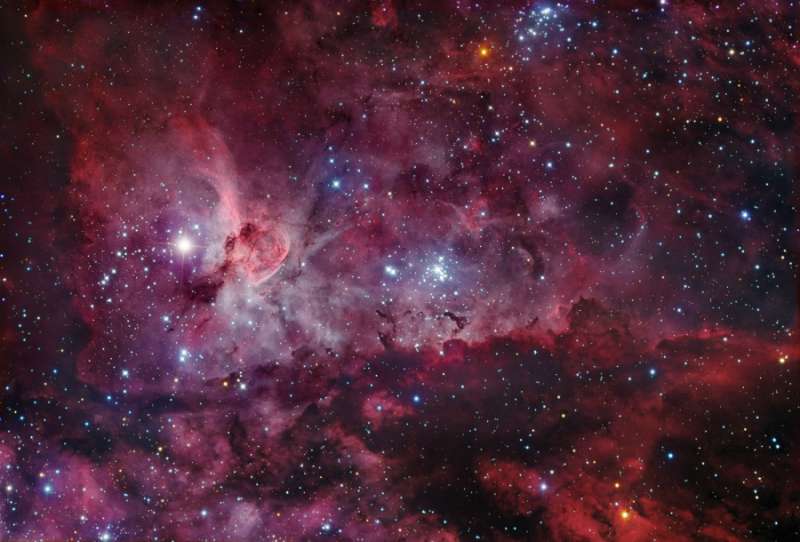
|
Credit & Copyright: Robert Gendler
(Processing),
Ryan Hannahoe
(Acquisition)
Additional data from the ESO/Danish 1.5m telescope at La Silla, Chile (R.Gendler, J.-E.Ovaldsen, C.Thöne, C.Feron).
Explanation:
A jewel of the southern sky,
the Great
Carina Nebula, also known as NGC 3372, spans over 300 light-years,
one of our galaxy's largest star forming regions.
Like the smaller, more northerly
Great Orion Nebula, the
Carina Nebula is easily visible to the
unaided eye, though at a distance of 7,500
light-years it is some 5 times farther away.
This
gorgeous telescopic portrait
reveals remarkable details of the region's glowing filaments of
interstellar gas
and obscuring cosmic dust clouds.
Wider than the Full Moon in
angular size,
the field of view
stretches nearly 100 light-years across the nebula.
The Carina Nebula is home to young, extremely massive stars, including
the still enigmatic variable
Eta Carinae, a
star with well over 100 times the mass of the Sun.
Eta
Carinae is the brightest star
at
the left, near the dusty
Keyhole Nebula (NGC 3324).
While Eta Carinae itself maybe on the verge of a supernova explosion,
X-ray images indicate that the Great Carina Nebula
has been a veritable
supernova factory.
Additional data from the ESO/Danish 1.5m telescope at La Silla, Chile (R.Gendler, J.-E.Ovaldsen, C.Thöne, C.Feron).
|
January February March April May June July August September October November December |
| ||||||||||||||||||||||||||||||||||||||||||||||||
NASA Web Site Statements, Warnings, and Disclaimers
NASA Official: Jay Norris. Specific rights apply.
A service of: LHEA at NASA / GSFC
& Michigan Tech. U.
Based on Astronomy Picture
Of the Day
Publications with keywords: Eta Carinae - carina nebula - Keyhole Nebula - star formation
Publications with words: Eta Carinae - carina nebula - Keyhole Nebula - star formation
See also:
- APOD: 2025 July 10 Á Lynds Dark Nebula 1251
- APOD: 2025 June 23 Á W5: Pillars of Star Formation
- APOD: 2025 April 28 Á Gum 37 and the Southern Tadpoles
- APOD: 2025 March 26 Á Star Formation in the Pacman Nebula
- APOD: 2024 October 22 Á M16: Pillars of Star Creation
- Star Factory Messier 17
- APOD: 2024 August 19 Á IC 5146: The Cocoon Nebula
